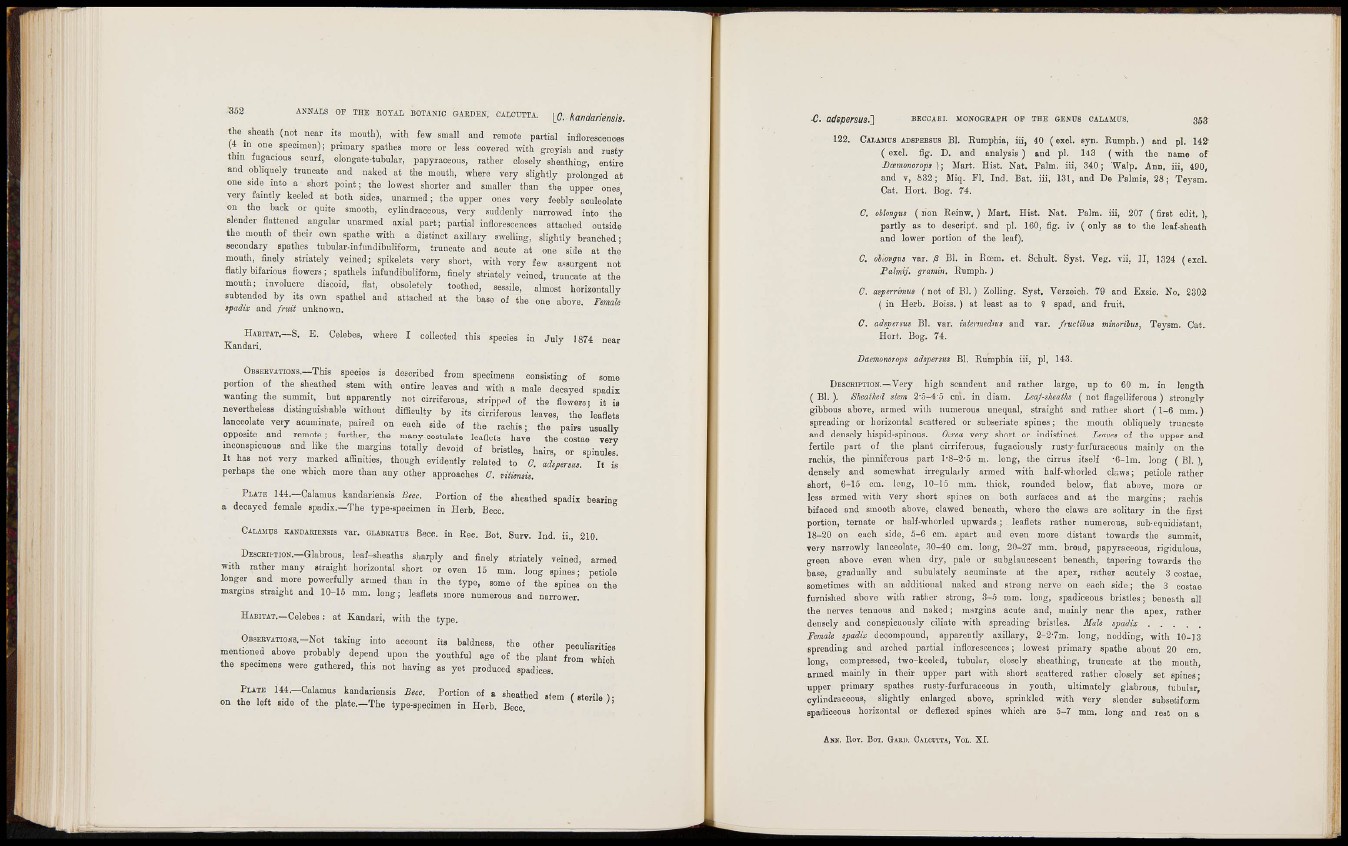
352 ANNALS OF THE ROYAL BOTANIC GARDEN. CALCUTTA. ffandahensis.
the sheath (not near its moiitL), with few small aud remote partial inflorescences
(4 lu one speciineD); primary spathea more or less covered with greyish aud rusty
thin fugacious scurf, elongate-tubular, papyraceous, rather closely sheathing, entire
and obliquely truncate and naked at the mouth, where very slightly prolonged at
one side into a short point; the lowest shorter and smaller than the upper ones
very faintly keeled at both sides, unarmed; tha upper ones very feebly aculeolate
on the back or quite smooth, cylindraceous, very suddenly narrowed into the
slender flattened angular unarmed axial part; partial inflorescences attached outside
the mouth of thci. own spathe with a distinct axillary awelUrg, slightly branched;
secondary spathes tubuIar-infundibuHform, truncate and acute at one side at the
mouth, finely striately veined; spikelets very short, with very fe^v a^surgeat not
flatly bifarioua flowers; spathels infundibuliform, finely striately veined, truncate at the
mouth; involucre discoid, flat, obsoletely toothed, sessile, almost horizontally
subtended by its own spathel and attached at the base of the cao above. Female
tpadix and fruit unknown.
HABITAT.—S, E, Celebes, where I collected this
Kandari.
in July 1874 near
0B8EEVATI0NS.-This species is described from specimeni, consisting of some
portion of the sheathed stem with entire leaves and with a male decayed spadiz
wantmg the summit, but apparently not cirriferous, stripped of the flowers- it is
nevertheless distinguishable without difBculty by its cirriferous leaves, the 'leaflets
lanceolate very acuminate, paired on each side of the rachis; the pai^s usually
opposite aud remote ; further, the many-oostulate leaflets have the costae very
inconspicuous and like the margins totally devoid of bristles, hairs or spinules
I t has not very marked affinities, though evidently related to (7. adspersus. It is
perhaps the one which more than any other approaches C. vitienm.
PLATE U 4 . - C a l a m u s kandariensia Beee. Portion of the sheathed spadix bearing
a decayed female spadix.—The type-specimen in Herb. Becc.
CALAMUS KAKDAEIENSIS var. GLABRATUS Beco. in Kec. Bot. SUIT. I n d . ii., 210.
DESCSIHION.—Glabrous, leaf-sheaths sharply and finely striately veined, armed
With rather many straight horizontal short or even 15 mm. long spiues • petiole
longer and more powerfully armed than in the type, some of the spines on the
margins straight and 10-15 mm. long; leaflets more numerous and narrower
HABITAT.—Celebes ; at Kandari, with the type.
QBSEEyATio«s.-Not takiug into account its baldness, the other peculiarities
mentionea above probably depend upou the youthful age of the plant from which
the specimens were gathered, this not having as yet produced spadices.
I ' ^ T u ^ ' ^ ^ r ^ f ^ ' T " oi a sheathed stem ( sterile )-
on the left side of the p l a t e . - T h e type-specimen in Herb. Becc. ^ ^
•C. adspersus.'] BECCAfil. MONOGRAPH OF THE GENUS CALAMUS. 35a
CALAMUS ADSPEHSUS B1. Eumphia, iii, 40 (excl. syn. Humph.) and pi. 142
( excl. fig. D. and analysis) and pi. l43 (with the name of
Dcemonorops ); Mart. Hist. Nat. Palm, iii, 340; Walp. Acn, iii, 490,
and V, S32; Miq. Fl. Ind. Bat. iii, 131, and De Palmia, 28; Teysm.
Cat. Hort. Bog. 74.
C. oihngus ( non Reinw. ) Mart. Hist. Nat. Palm, iii, 207 (first edit.),
partly as to descript. and pi. 160, fig. iv ( only as to the leaf-sheath
and lower portion of the leaf).
C. oiiotiffUi var. /9 Bl. in Rccm. et. Schult. Syst. Veg. vii, II, 1324 (excl.
I'almij. gramin. Humph. )
3ich. 79 and Exsic. No. 2302
I . and fruit.
C. asperrimus (not of Bl.) Zolling. Syst.
( in Herb. Boiss. ) at least as to ?
C. adspersus Bl. var. intermedma and var. fruciibua minorilus, Teysm. Cat.
Hort. Bog. 74.
Daemonorops adspersus Bl. Rumphia iii, p], 143.
DESCEIPTION.—Very high scandent and rather large, up to 60 m. in length
( Bl. ). Sheathed stem 2-5-4-5 cm. in diam. Leaf-sheaths ( not flagelliferous) strongly
gibbous above, armed wilh numerous unequal, straight and rather short ( 1 - 6 mm.)
spreading or horizontal scattered or subseriate spines; the mouth obliquely truncate
and densely hispid-spinous. Ocrea very short or indistiuct. Leaves of the upper and
fertile part of the plant cirriferous, fugaeiously rusty-furfuraceous mainly on the
rachis, the pinniferous part 1-8-2-5 m. long, the cirrus itself -e-lm. long ( Bl. ),
densely and somewhat irregularly armed -with half-whovled claws; peiiolo rather
short, 6-15 cm. long, 10-15 mm. thick, rounded below, fiat above, more or
less armed with very short spines on both surfaces and at the margins; rachis
bifaced and smooth above, clawed beneath, where the claws are solitary in the first
portion, ternate or half-whorled upwards ; leaflets rather numerous, sub-equidistant,
18-20 on each side, 5-6 cm. apart and even more distant towards the summit,
very narrowly lanceolate, .30-40 cm. long, 20-27 mm. broad, papyraceous, rigidulous,
green above even when dry, pale or subglaucescent beneath, tapering towards the
base, gradually and subulately acuminate at the apex, rfither acutely 3 costae,
sometimes with an additional naked and strong nerve on each sidG; the 3 costae
furnished above with ratlier strong, 3-5 mm. long, spadiceous bristles; beneath all
the nerves tenuous and naked; margins acute and, mainly near the apex, rather
densely and conspicuously ciliate with spreading bristles. Male spadiz
Female spadix decompound, apparently axillary, 2-2'7m. long, nodding, with 10-13
spreading and arched partial inflorescences; lowest primary spathe about 20 cm.
long, compressed, two-keeled, tubuhir, closely sheathing, truncate at the mouth,
armed mainly in their upper part with short scattered rather cloaely set spines;
upper primary spathes rusty-furfuraceous in youth, ultimately glabrous, tubular,
cylindraceous, slightly enlarged above, sprinkled with very slender subsetifoim
spaiiicooua horizontal or deflexed spines which are 5-7 mm. long and rest on a
ANN. EOY. BOI. GABI». CALCUTTA, YOL. X I.